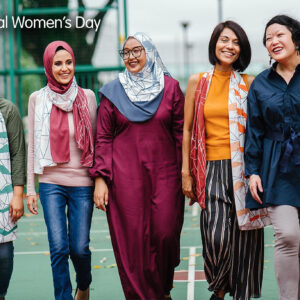 EDMONTON – When Metis artist Christi Belcourt heard about the disappearance of a number of indigenous women in her area, she was overwhelmed with emotion. “It hit me like a stab to the heart because I was thinking of their mom, because I am a mom.” This was the emotional breakthrough that birthed Walking With Our Sisters, a commemorative art installation to honour the lives of missing and murdered indigenous women across Turtle Island.
EDMONTON – When Metis artist Christi Belcourt heard about the disappearance of a number of indigenous women in her area, she was overwhelmed with emotion. “It hit me like a stab to the heart because I was thinking of their mom, because I am a mom.” This was the emotional breakthrough that birthed Walking With Our Sisters, a commemorative art installation to honour the lives of missing and murdered indigenous women across Turtle Island.
The work opened with proper ceremony and protocol guided by elders at the Telus Centre Atrium on October 2 at the University of Alberta. This memorial was one of the many events across the country last week remembering the lives of those women lovingly referred to as our “Sisters In Spirit”, giving the indigenous community a place to grieve the lost.
Belcourt initially put out the call on social media for people to mail in “vamps”; the top decorated part of a moccasin, to be included in a memorial piece honouring the lives of the women and their grieving families. The goal was to have 600 vamps, one pair for each of the women to be honoured. Belcourt says, “I thought realistically we would get 400-500. And then when things started picking up I thought we would get 600 for sure. In one month we got over a thousand and they had just started arriving.”
 In total 1726 vamps were received by the Walking With Our Sisters Collective for this work, including several hundred from the Haudenosaunee community. As the exhibit grew, so did the purpose and intention behind the work. Notes were being submitted with vamps explaining that an intimate level of ceremony was observed while creating each piece. “A lot of people sent notes on Facebook that said if they weren’t feeling good that day or they were in a bad mood they would put the beadwork down because their grandmothers taught them the energy you have gets transferred into the work you are doing,” said Belcourt. “Those vamps have a whole lot of energy in them. When all that love gets stitched into something I don’t know if it is something we can comprehend with our minds but it speaks to our soul, it speaks to our spirit.”
In total 1726 vamps were received by the Walking With Our Sisters Collective for this work, including several hundred from the Haudenosaunee community. As the exhibit grew, so did the purpose and intention behind the work. Notes were being submitted with vamps explaining that an intimate level of ceremony was observed while creating each piece. “A lot of people sent notes on Facebook that said if they weren’t feeling good that day or they were in a bad mood they would put the beadwork down because their grandmothers taught them the energy you have gets transferred into the work you are doing,” said Belcourt. “Those vamps have a whole lot of energy in them. When all that love gets stitched into something I don’t know if it is something we can comprehend with our minds but it speaks to our soul, it speaks to our spirit.”
As the vamps arrived, the collective realized the work was transitioning from a commemorative memorial to a ceremonial responsibility. The project shifted again after Belcourt’s partner, Alo White, had a dream. In it, there were two eagle staffs present at the showing of the vamps, and an old lady was tying an eagle feather onto one of the staffs. When he asked her in the language “What are you doing?” she answered, “I’m putting this on in memory of my daughter.” He made these eagle staffs according to the dream and said that one of them is for missing women and the other one is for women who have been killed. Those staffs are now present at the viewing for family members to tie on feathers for their loved ones.
The memorial is installed following a specific ceremonial protocol. “We create the space as a sacred space. In some areas we lay down sage, in some areas people choose to lay tobacco, or cedar depending on the traditions of the area we are in.” says Belcourt.
The showing is begun with an opening ceremony and there are helpers who smudge with the show day and night. “It feels like a wake. You don’t want to leave them. It’s a really strange feeling everybody gets protective about them. It feels like we are in ceremony and nobody wants to go. At the same time it is a celebration of life, it is recognizing that their lives were valued.”
As the collection is passed to the next community, it will be prepared as a sacred bundle and passed to an appointed “keeper of the vamps”; a traditional indigenous woman who works with elders of the community to ensure local traditional protocols are observed. Belcourt says because of all the ceremonial aspects, the showing has grown into something of its own. “It is more than an art exhibit. It is very much creating a sacred space and doing that means it is not just a curiosity.” For this reason requests to take the show outside of North America have not been accepted. Belcourt says, “It’s not meant to be outside of our territory because it is meant for us. We are inviting the non-indigenous community to come and experience with us.”
While the journey has just begun, already an impact has been made across the indigenous nations of Turtle Island. Belcourt says, “It’s so much more than re-‘Tweet’ing something or hitting ‘like’. It’s transcended social media into the real world, and then back into social media again. It’s shown that social media can just be a platform for action taking place in the real world.”
Walking With Our Sisters is on display at the University of Alberta until October 13. It is set to arrive in Kahnawake and Akwesasne in 2017 and Six Nations is scheduled to be the second to last stop on the tour in 2018. The tour will then be concluded with a traditional ceremony in Batoche, SK. For more information on the project you can visit the website www.walkingwithoursisters.ca.
(photots of the kahnawake beading club courtesy of www.walkingwithoursisters.ca website)








Comments are closed.